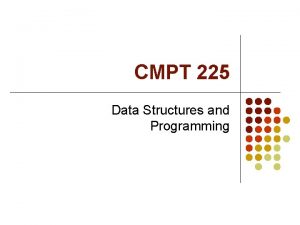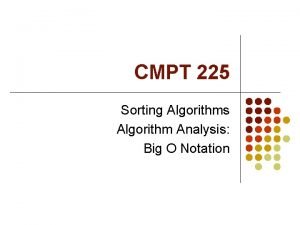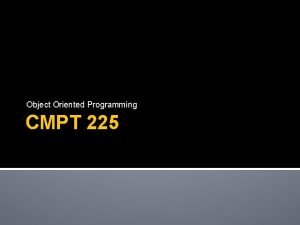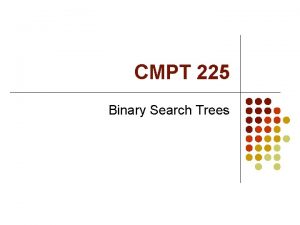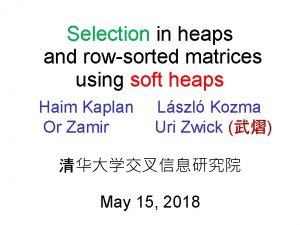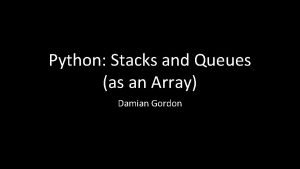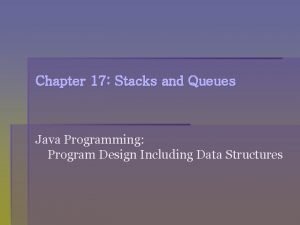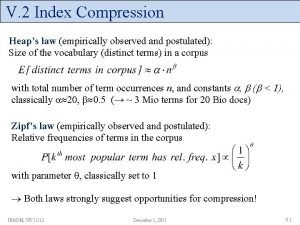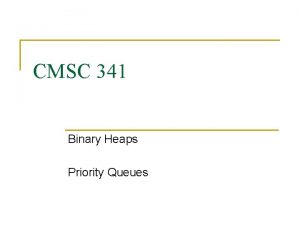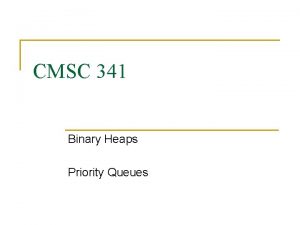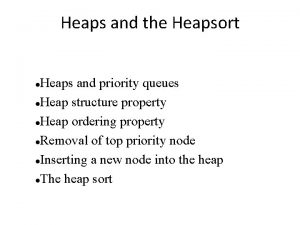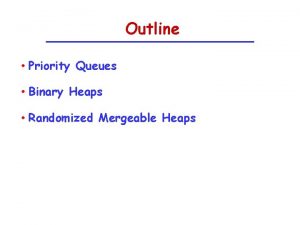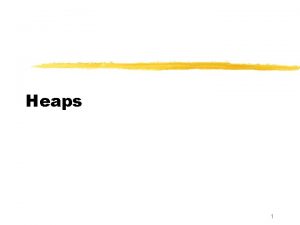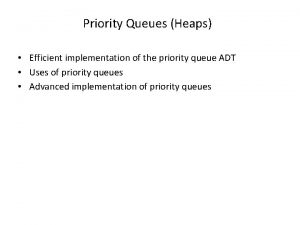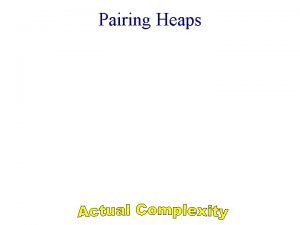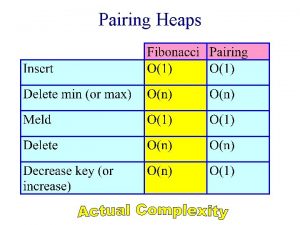CMPT 225 Priority Queues and Heaps Priority Queues

























- Slides: 25

CMPT 225 Priority Queues and Heaps

Priority Queues l Items in a priority queue have a priority l l The priority is usually numerical value Could be lowest first or highest first The highest priority item is removed first Priority queue operations l l Insert Remove in priority queue order (not a FIFO!)

Using a Priority Queue 4 5 1 6 2 3

Implementing a Priority Queue l l Items have to be removed in priority order This can only be done efficiently if the items are ordered in some way l l A balanced binary search (e. g. , red-black) tree is an efficient and ordered data structure but l Some operations (e. g. removal) are complex to code l Although operations are O(log n) they require quite a lot of structural overhead There is another binary tree solution – heaps l Note: We will see that search/removal of the maximum element is efficient, but it’s not true for other elements

Heaps l l A heap is binary tree with two properties Heaps are complete l l l All levels, except the bottom, must be completely filled in The leaves on the bottom level are as far to the left as possible. Heaps are partially ordered (“heap property”): l l The value of a node is at least as large as its children’s values, for a max heap or The value of a node is no greater than its children’s values, for a min heap

Complete Binary Trees complete binary trees incomplete binary trees

Partially Ordered Tree – max heap 98 86 41 13 9 65 10 44 32 23 21 29 17 Note: an inorder traversal would result in: 9, 13, 10, 86, 44, 65, 23, 98, 21, 32, 17, 41, 29

Priority Queues and Heaps l l l A heap can be used to implement a priority queue Because of the partial ordering property the item at the top of the heap must always the largest value Implement priority queue operations: l l l Insertions – insert an item into a heap Removal – remove and return the heap’s root For both operations preserve the heap property

Heap Implementation l l Heaps can be implemented using arrays There is a natural method of indexing tree nodes l l Index nodes from top to bottom and left to right as shown on the right (by levels) Because heaps are complete binary trees there can be no gaps in the array 0 2 1 3 4 5 6

Array implementations of heap public class Heap<T extends Keyed. Item> { private int HEAPSIZE=200; // max. number of elements in the heap private T items[]; // array of heap items private int num_items; // number of items public Heap() { items = new T[HEAPSIZE]; num_items=0; } // end default constructor l l We could also use a dynamic array implementation to get rid of the limit on the size of heap. We will assume that priority of an element is equal to its key. So the elements are partially sorted by their keys. They element with the biggest key has the highest priority.

Referencing Nodes l l l It will be necessary to find the indices of the parents and children of nodes in a heap’s underlying array The children of a node i, are the array elements indexed at 2 i+1 and 2 i+2 The parent of a node i, is the array element indexed at floor[(i– 1)/2]

Helping methods private int parent(int i) { return (i-1)/2; } private int left(int i) { return 2*i+1; } private int right(int i) { return 2*i+2; }

Heap Array Example 98 Heap: 86 13 9 7 1 41 3 65 10 8 0 44 9 4 32 10 23 11 21 2 5 29 17 6 12 Underlying Array: index 0 1 2 3 4 5 6 7 value 98 86 41 13 65 32 29 9 8 9 10 11 12 10 44 23 21 17

Heap Insertion l On insertion the heap properties have to be maintained; remember that l l l A heap is a complete binary tree and A partially ordered binary tree There are two general strategies that could be used to maintain the heap properties l l l Make sure that the tree is complete and then fix the ordering, or Make sure the ordering is correct first Which is better?

Heap Insertion algorithm l The insertion algorithm first ensures that the tree is complete l l l Make the new item the first available (left-most) leaf on the bottom level i. e. the first free element in the underlying array Fix the partial ordering l l Repeatedly compare the new value with its parent, swapping them if the new value is greater than the parent (for a max heap) Often called “bubbling up”, or “trickling up”

Heap Insertion Example 98 Insert 81 86 41 13 9 index value 65 10 0 1 44 2 3 32 23 4 5 21 29 17 6 7 98 86 41 13 65 32 29 9 8 9 10 11 12 13 10 44 23 21 17 81

Heap Insertion Example 81 is less than 98 so we are finished 98 Insert 81 86 81 41 13 9 65 10 44 32 23 21 29 41 81 17 29 81 (13 -1)/2 = 6 index value 0 1 2 3 4 5 6 81 13 65 32 29 41 81 98 86 41 7 9 8 9 10 11 12 13 10 44 23 21 17 29 81

Heap Insertion algorithm public void insert(T new. Item) { // TODO: should check for the space first num_items++; int child = num_items-1; while (child > 0 && item[parent(child)]. get. Key() < new. Item. get. Key()) { items[child] = items[parent(child)]; child = parent(child); } items[child] = new. Item; }

Heap Removal algorithm l l Make a temporary copy of the root’s data Similar to the insertion algorithm, ensure that the heap remains complete l l Replace the root node with the right-most leaf on the last level i. e. the highest (occupied) index in the array Repeatedly swap the new root with its largest valued child until the partially ordered property holds Return the root’s data

Heap Removal Example 98 Remove root 86 41 13 9 index value 65 10 0 1 44 2 3 32 23 4 5 21 29 17 6 7 98 86 41 13 65 32 29 9 8 9 10 11 12 10 44 23 21 17

Heap Removal Example ? Remove root ? 98 17 86 replace root with right-most leaf 17 86 41 13 9 65 10 44 left child is greater 32 23 21 29 17 children of root: 2*0+1, 2*0+2 = 1, 2 index value 0 1 2 3 4 5 6 7 17 86 17 98 86 41 13 65 32 29 9 8 9 10 11 12 10 44 23 21 17

Heap Removal Example 86 Remove root 17 65 ? 41 ? 13 9 right child is greater 65 17 10 44 32 23 29 21 children: 2*1+1, 2*1+2 = 3, 4 index value 0 1 2 3 4 5 6 7 17 86 65 86 41 13 17 65 32 29 9 8 9 10 11 10 44 23 21 12

Heap Removal Example 86 Remove root left child is greater 65 41 13 32 44 17 ? 29 ? 98 86 9 10 17 44 23 21 13 9 children: 2*4+1, 2*4+2 = 9, 10 index value 0 1 2 3 4 5 6 7 86 65 41 13 44 17 32 29 9 8 9 41 65 10 44 10 11 10 17 44 23 21 32 23 12 21 29 17

Heap Removal algorithm public T remove() // remove the highest priority item { // TODO: should check for empty heap T result = items[0]; // remember the item T item = items[num_items-1]; num_items--; int current = 0; // start at root while (left(current) < num_items) { // not a leaf // find a bigger child int child = left(current); if (right(current) < num_items && items[child]. get. Key() < items[right(current)]. get. Key()) { child = right(current); } if (item. get. Key() < items[child]. get. Key()) { items[current] = items[child]; current = child; } else break; } items[current] = item; return result; }

Heap Efficiency l For both insertion and removal the heap performs at most height swaps l l l For insertion at most height comparisons For removal at most height*2 comparisons The height of a complete binary tree is given by log 2(n) +1 l Both insertion and removal are O(logn) Remark: but removal is only implemented for the element with the highest key!
 Cmpt 225 sfu
Cmpt 225 sfu 81mod23
81mod23 Cmpt 225
Cmpt 225 Cmpt 225
Cmpt 225 Cmpt 225
Cmpt 225 Cmpt 225
Cmpt 225 Cmpt 225
Cmpt 225 225 in binary
225 in binary Queue quiz
Queue quiz Adaptable priority queues
Adaptable priority queues Applications of priority queues
Applications of priority queues Burman's priority list gives priority to
Burman's priority list gives priority to Priority mail vs priority mail express
Priority mail vs priority mail express Soft heaps of kaplan and zwick uses
Soft heaps of kaplan and zwick uses Empty python
Empty python Java stacks and queues
Java stacks and queues Java stack exercises
Java stack exercises Java stacks and queues
Java stacks and queues Heaps of love ice cream
Heaps of love ice cream Lazy binomial queue
Lazy binomial queue Skew heaps
Skew heaps What does cumulus mean
What does cumulus mean Heaps x united style
Heaps x united style Heaps cs
Heaps cs Tom heaps
Tom heaps Heap's law
Heap's law
